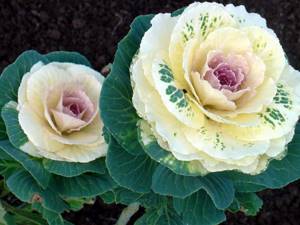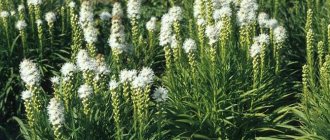Ornamental cabbage is no different in care from a regular table crop and can be eaten. Its main feature is bright, unusually colored leaves and rosettes resembling large flowers or ornamental trees. You can learn more about the varieties and methods of growing ornamental cabbage from this article.
Decorative cabbage
Ornamental cabbage is a biennial plant
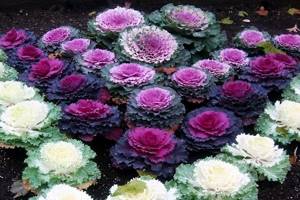
Ornamental cabbage blooms until frost
Botanical description
Ornamental cabbage is classified as headless cabbage (Brassica oleracea var. Acephala), also called Brassica. Belongs to the cruciferous family. Biennial plant. In the first year, the leaves develop, forming a loose head or rosette; in the second year, the plant blooms and bears fruit.
The shape of ornamental cabbage leaves can be:
- solid and flat;
- pinnately dissected;
- corrugated;
- with fringed edge;
- with a curly edge.
The plant acquires the following colors:
- green on the lower leaves and white on the central ones;
- green on the lower ones and red-purple on the central ones;
- bright outer edge of the leaf and green in its central part;
- purple, pink, white central part and green edge of leaves;
- multi-colored leaves with contrasting veins.
The plant acquires a bright color when the temperature drops below +10 °C.
Cabbage can “bloom” in open ground until frosts of -12 °C, and after being moved to an unheated room - until mid-winter.
Types and varieties of ornamental cabbage
The variety of varieties and names of ornamental cabbage is amazing. Here is just a small part of them:
Also read: Scilla: characteristics of species and planting features
Princess
It is an annual plant that grows up to a third of a meter tall with a dense rosette of green, yellow, dark or light crinkled, toothed leaves. Decorative coloring appears from August.
Mosbach
It grows up to half a meter, and the span of its lyre-like curly leaves reaches almost a meter in volume. The shape of the plant is dome-shaped, and the color is juicy and green.
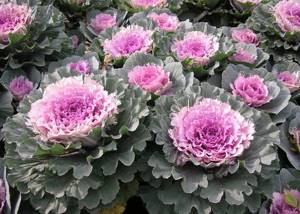
Decorative cabbage Princess
Lark's tongue
Almost human-sized curly cabbage. The ovoid-shaped leaves are colored in different shades of green. The plant looks like a palm tree.
Burgundy lace
The leaves of this half-meter plant are strongly corrugated and formed into a two-color rosette with a burgundy core framed by an emerald green.
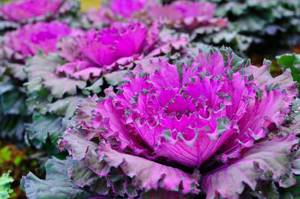
Decorative cabbage Burgundy lace
Historical data
Ancient Greece is considered the historical homeland of this type of cabbage. Here there was a special attitude towards the plant, since it was believed that the growth of the vegetable was provoked by drops of sweat from the god Jupiter.
Japanese breeders have made a lot of improvements in the variety of appearance of ornamental plants. Already in the middle of the 18th century, more than 200 varieties were bred here. Unusual-looking cabbage decorated the gardens of wealthy Japanese. Ornamental cabbage is widespread in European countries. In our country, it is just beginning to gain the attention of gardeners.
Where is it used and can it be eaten?
Ornamental cabbage is used in landscape design.
It can be planted:
- as part of compositions with flower plants - they form a contrasting spot against the background of other flowers and tall plants;
- as living borders - planted along paths and enclosing flower beds;
- in flowerpots and hanging flower pots – you can grow both individual plants and groups;
- as a single plant - completely plant the space with only ornamental cabbage;
- as part of compositions from different varieties - creating multi-colored patterns;
- in alpine slides - you can use both high and low varieties.
You can create original bouquets from Brassica. To do this, it is cut off at the root and placed in a vase with a small amount of water. To make the bouquet last longer, add a few crystals of potassium permanganate or 1 tsp to the water. sugar and a pinch of salt per 1 liter of water. Change the water 2 times a week, and the bouquet will last about a month.
In floristry, decorative cabbage is used to create vegetable bouquets.
Most often, ornamental cabbage was grown as a fodder plant, but it is quite edible, like cabbage or cauliflower. The leaves are rich in vitamins and can be a good source of them in winter.
A peculiarity of ornamental cabbage is that the leaves lose their bitter taste after the first frost.
Rules of care
Growing this flower is not difficult. The most important thing is to water, weed, fertilize and loosen the soil in a timely manner.
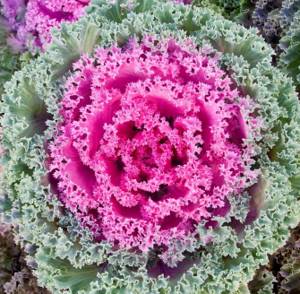
Some care features:
- It is better to water and spray plants in the morning or evening.
- To saturate the soil with oxygen, it is necessary to loosen it around the plants after rain or after watering once a week.
- You should water the plant every day if dry days come.
- To ensure full flower growth, it is necessary to weed the beds to remove weeds.
- Once every ten days, cabbage is fed with mineral fertilizers or mullein. You should not feed the soil with manure, since when growing ornamental cabbage, such feeding allows the leaves to grow larger, but their color will become mostly green, which will affect the decorative appearance of the plant.
If properly cared for, cabbage will bloom from July to October. She is not afraid of sub-zero temperatures. Even at frosts of -10 degrees the plant will retain its beauty.
Landing dates, place and conditions
Ornamental cabbage belongs to the mid-season and late-ripening groups of plants. The growing season lasts from 140 to 160 days. Rosettes of colored leaves form in August and persist until October, in some varieties until November.
The site for its planting must be selected taking into account the late “flowering” period. First, early and annual flowers should bloom, and cabbage should not cover them. It can be planted along the fence or left in pots and then transferred to a flower bed.
Brasseca loves open areas and semi-shaded areas. The soil it prefers is loam and sandy loam soil. Like any cabbage, ornamental varieties do not like acidic soil.
When growing in open ground, the site should be prepared in the fall:
- Application of fertilizing. 3 kg of compost, 50 g of superphosphate, 20 g of ammonium sulfate and 20 g of potassium chloride. Distribute the mixture over 1 square. m of land.
- Digging. Dig up the flowerbed.
- Watering. Moisturize well.
- Shelter. Cover the area with polyethylene or other insulating material so that the applied fertilizers rot well.
In the spring, remove the covering material and dig and loosen the soil well.
Sowing ornamental cabbage for seedlings
There are 2 ways to grow cabbage for seedlings. Whichever one you choose, you will have to take into account some nuances.
Tips for growing seedlings
Being a cold-tolerant plant, cabbage will react negatively to heat rather than cold. Keep this in mind if you want to grow seedlings in a hot apartment. In such conditions it is better to wait until April or May. During these periods, you can still grow seedlings, although March-April is considered the ideal time.
After the first shoots appear, on about the 5th day, the container with the seedlings should be moved to a cool place and provided with good lighting for 12-15 hours a day. Otherwise, the plants will become very tall. Phytolamps are used to illuminate seedlings. If it is not possible to provide lighting to the seedlings, it is better to wait until the day naturally increases.
Ornamental cabbage seedlings are often affected by fungal diseases, so the seed and soil should be disinfected before planting:
- the soil is calcined in the oven;
- after cooling, treat with Fitosporin;
- in a damp-wet state, the soil is left for several hours;
- the seeds are soaked for 3-4 hours in a solution of Fitosporin or kept for 20 minutes in water at a temperature of 50 ° C, and then in a solution of potassium permanganate.
After these steps, you can begin sowing. Granulated, purchased seeds can be planted immediately without additional processing.
With a pick
This method is used if you need to grow a large amount of seedling material.
Sequence of work:
- Fill the containers with soil. Its thickness should be at least 5 cm. Lightly compact it.
- Make grooves 0.5-1 cm deep. There should be a distance of 3 cm between the grooves.
- Place the seeds in grooves 1 cm apart. To do this, it is convenient to use a match or a toothpick.
- Fill the grooves with soil and compact it slightly so that there are no air pockets inside.
- Moisten the soil. Make sure it is damp but not puddling.
- Create a greenhouse. To do this, cover the container with polyethylene and secure it with an elastic band around the perimeter.
- Place the seedlings in a warm place. The temperature should be within +18-+24 °C. Light doesn't really matter at this stage.
If the work is carried out correctly, there is no need to water the cabbage before picking. After the first true leaves appear, after about 8-12 days, the cabbage is picked:
- Prepare the required number of pots with a volume of 250 ml and fill them with soil mixture treated with Fitosporin.
- Holes 2-3 cm deep are made in the ground.
- Each sprout is dug out with a small spatula, along with a lump of earth, and transferred to pots.
- Plants are deepened down to the cotyledon leaves. The earth around is being compacted.
- Plants are watered by spraying with warm water.
- Seedlings need to be fed before transplanting into the soil with liquid vermicompost or Agricola fertilizer. The procedure is carried out:
- on the 14th day after sowing;
- on day 28;
- before planting in the ground.
- 10 days before planting in a flower bed, the seedlings are hardened off. First, they open the window, and then take it out onto the street or balcony. Start with 30 minutes, gradually increasing this time to the whole day.
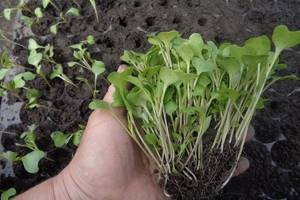
Without picking
It involves sowing seeds directly into separate pots:
- Prepare the required number of pots and fill them with prepared soil.
- Holes up to 1 cm deep are made in the soil (1 pot - 1 hole).
- Place 2-5 seeds in each hole and cover with soil.
- The pots are covered with polyethylene, creating greenhouse conditions.
- After germination, weak shoots are removed, cutting them off close to the ground with sharp thin scissors (you can use nail scissors), leaving one of the healthiest seedlings.
Planting ornamental cabbage in open ground
The optimal temperature for transplantation is considered to be +14-+18 °C. The soil should warm up to +8-+10 °C.
Cabbage can withstand night frosts down to -4 °C without harm.
At the time of transfer to the ground, the plant should develop 2-3 pairs of true leaves. The transplant is carried out together with a clod of earth, so the seedling will take root better.
Work order:
- Prepare the wells . Planting pattern 25x40 cm. Pour 1 tsp into each hole. complex fertilizer and ash.
- Transfer. Transfer each seedling to a separate hole. They deepen it to the cotyledon leaves and cover it with earth, slightly compacting it.
- Shelter. The seedlings are covered with agrofibre until the plant takes root.
Planting cabbage from seeds
Ornamental cabbage seeds can be purchased at a specialty store or collected from the garden.
How to collect seeds?
Cabbage produces an arrow in which the seeds ripen in the 2nd year of life. Only the best rosettes are selected for seeds. To collect them:
- In the fall, dig up the cabbage by the roots from the garden bed;
- remove the lower leaves;
- bury leaves up to the leaves in a container with wet sand;
- store in this condition until spring in a well-ventilated, cool and dry place;
- in the spring, transplant the rosette into the ground;
To improve pollination, plant cabbage plants close to each other.
- in June the cabbage will begin to shoot arrows;
- the seeds in the pods will ripen by November;
- When they are well dry, cut them off and thresh them.
To prevent birds from eating the seeds, the arrows are tied with cloth.
Sowing in greenhouse conditions
Before sowing seedlings in a greenhouse, first prepare the soil:
- mix the soil from the site, peat and sand so that the layer thickness is 10 cm;
- disinfect this substrate.
Next, sow the seeds:
- moisten the soil well, but do not flood it;
- make small depressions in the ground;
- Place 2-3 seeds in each hole;
- sprinkle them with earth;
- you can cover the bed with polyethylene to increase the temperature;
- after germination, remove the cover;
- carry out loosening and watering.
When the plants have 2-3 true leaves, you can transfer the seedlings to open ground.
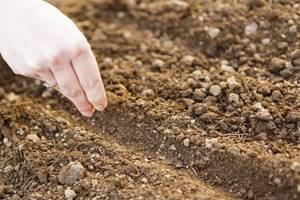
Sowing in open ground
"Brassica" can be sown immediately in open ground. It is better to do this in late April-early May. In unfavorable weather conditions, temporary shelter should be provided.
Work order:
- Preparation. Loosen the soil well.
- Watering. Moisten the soil with hot water with the addition of potassium permanganate, this will also serve as disinfection;
- Holes or grooves. Make small holes up to 1.5 cm deep at a distance of 15 cm from each other; you can make grooves of the same depth.
- Sowing. Place seeds in each groove at a distance of 5 cm from each other, or 1-3 seeds in each hole and cover with soil.
- Shelter. Cover each hole with a cut bottle. Install arcs along the rows and stretch the film over them.
In cold weather, seedlings can wait up to 2-3 weeks.
- Removing cover. When the sprouts hatch, the cover must be removed.
- Watering. Start after the true leaf appears. During watering, alternate the solution of Fitosporin and complex fertilizer.
- Thinning. Thin out the seedlings as they grow, leaving the strongest ones.
- Transfer. After 2-3 true leaves appear, the plants can be moved to a permanent location.
How to grow cabbage without seedlings
It is possible to immediately sow seeds in the garden without planting seedlings. To do this, first prepare a bed. The soil is dug up with a shovel and enriched with mineral fertilizers. After this, the substrate must be disinfected with a solution of potassium permanganate. Furrows are “cut” in the garden bed and cabbage is sown. After a couple of weeks, the seedlings sprout into the beds. After the first leaf has formed, you need to water the plant and start fertilizing.
Popular: A wide variety of radishes: varieties and types of vegetables
At first, the bed is covered with plastic film, like a greenhouse. It is regularly ventilated. After the seedlings have grown, the film is opened for a long period. When it becomes very warm outside, the film can be removed completely. Instead of film, some gardeners use old cut bottles to cover the bushes. If frosts suddenly occur, then you should not be afraid. Seedlings can withstand short temperature drops down to −4 degrees. Adult bushes of ornamental cabbage will not die even in frosts from 8 to 12 degrees.
How to care for ornamental cabbage?
Even a novice gardener can handle caring for ornamental cabbage.
Watering
Ornamental cabbage varieties need to be watered in a timely manner. To do this, 10 liters of water moisten 1 square meter. m of soil. In stable hot weather, watering is carried out every day in the morning or evening.
Cabbage grown in containers is watered abundantly in the morning or evening, and also sprayed to reduce evaporation.
Loosening
After watering, the soil needs to be loosened, thus improving air exchange in the root zone and roots. Carry out the procedure once every 7 days.
In addition to loosening, carry out hilling. Rake the soil under each bush. This way you can prevent the grown cabbage rosette from falling over, which becomes too heavy to stay on the stem.
Weeding
Periodically weed flower beds with ornamental cabbage. It is best to combine it with watering and loosening - it is easier to remove weeds along with the roots from wet, loose soil.
The flowerbed can be mulched with any suitable material: sawdust, straw, shavings, mown grass, dried weeds. Thereby reducing the number of watering, weeding and loosening.
Fertilizer
You need to feed ornamental cabbage 3 times per season:
- 2 weeks after planting. Add a solution of urea (30 g per 1 sq. m) or mullein (diluted in water 1 to 10). Nitrogen fertilizers are used with caution, as they help increase green mass, but impair the decorativeness of plants.
- In 3-4 weeks. Nitroammofoska (10 g for each plant) or Azofoska solution (30 g diluted in 0.5 liters of water) is embedded in the soil.
- After another 3-4 weeks, repeat the 2nd feeding.
On poor soils, fertilizing is applied 4-5 times per season.
Options for use in landscape design
It is not for nothing that ornamental cabbage is often called a flower; its beauty and variety of colors and shapes can, without exaggeration, be compared with the recognized queen of flowers - the rose. But the exotic vegetable flower has an advantage - cabbage is also tasty and healthy. And its flowering only becomes more colorful and brighter in cold weather. It looks great and regal in any composition. And here are examples of this.
Decorative cabbage in flower beds
When planting in a flowerbed, the following options are possible:
- By alternating white and colored heads in a checkerboard pattern, you can get a surprisingly colorful chessboard.
- Plants of the same species, but of different colors (this is observed in Nagoya or Osaka hybrids), planted in the form of a huge flower or geometric figure, will resemble an English classical garden.
- By placing tall specimens in the center of the flower garden, framed by lacy, low-growing species, you can give it volume. The effect will be enhanced by a play of colors with alternating dark and light stripes.
- A good option is to zone areas with decorative bushes that form different shapes, each in its own color scheme.
- Non-standard flower beds look original in the form of baskets of flowers, carts, barrels or even an impromptu truck filled with bright bouquets of cabbage flowers.
Also read: Incarvillea or garden gloxinia: planting and growing, care recommendations
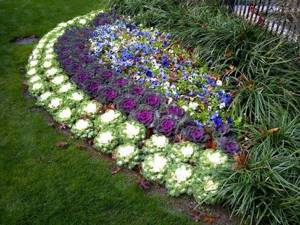
A good option is zoning areas with decorative cauliflower bushes.
Container growing of ornamental cabbage
This option is convenient because when cold weather sets in, you can move the compositions to the terrace, winter garden or glazed balcony. Several options for this method of decorating a site:
- Fence a resting place or path with cabbage tubs and place them symmetrically next to the bench.
- You can build a large colorful pyramid from special containers. Moreover, to make it look like a favorite children’s toy, plant cabbage “rings” of contrasting colors at different levels.
- A simple but impressive-looking solution: planting three contrasting colors of plants against the background of lawn grass in a large flowerpot.
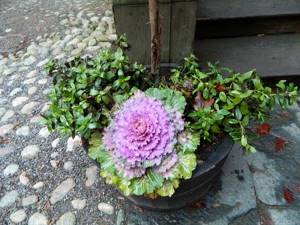
The container growing option is convenient because when cold weather sets in, you can move the compositions to the terrace
Joint planting with other plants
Cabbage flowers get along well with other plants in diverse compositions:
- Miniature gardens in containers with herbs and St. John's wort, and dark varieties of cabbage look good against their golden-green background.
- Climbing plants and species with small leaves and flowers, such as begonia, are good neighbors. This picture resembles an outlandish carpet with a large pattern in the middle.
- Against the background of a solid wall of climbing ivy or wild grapes that change color seasonally, flowers made from cabbage of different colors look advantageous.
- Pink flowers can be planted in groups of three, shading them with summer flowers, and on the far line with low bushes. It is better to plant cabbage roses in purple or green shades, and the flowers should be orange or yellow.
- Alpine hills look great, where fesalis and marigolds are present in company with ornamental cabbage.
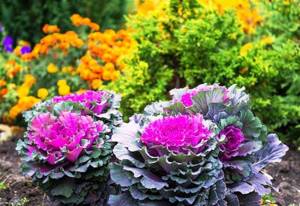
Cabbage flowers get along well with other plants in diverse compositions
Diseases, pests and prevention
Brassica can be affected by diseases and pests, just like table cabbage.
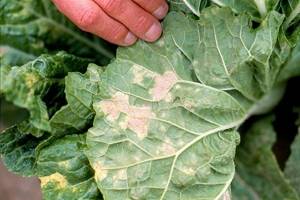
The most common diseases can be caused by:
- Excessive watering. Never allow the soil to become waterlogged and do not use cold water. Otherwise, there is a danger of developing powdery mildew and root rot.
- Excessive nitrogen fertilization. Increases susceptibility to disease.
- Acidic soil. Becomes the cause of clubroot development. If necessary, deoxidize the soil with lime or dolomite flour.
If infection cannot be avoided:
- at the initial stage, you can use the fungicides Fundazol, Quadris, Tiovit Jet;
- in case of severe damage, the rosettes should be removed from the garden bed.
Of the pests, ornamental cabbage is most often affected by:
- butterflies and caterpillars of cutworms and white moths;
- cruciferous flea beetle;
- aphids;
- slugs.
You can use the following tools and methods:
- insecticides Aktara, Bicol, Decis Profi;
- spraying the planting every 10-14 days with an infusion of tobacco dust (infuse 2 cups per 5 liters of water for 24 hours) with the addition of a few tablespoons of liquid soap;
- pollinate plants with ash with the addition of tobacco dust;
- plant a flowerbed with marigolds or other strong-smelling plants;
- mulch with pine needles;
- collect slugs and caterpillars by hand or lay out special traps.
Reproduction
Ornamental cabbage propagates only by seeds, but the plant should not be classified as a hybrid. Hybrid seeds collected at home do not retain their color and decorative characteristics. Harvested seeds can be stored for 5 years.
High-quality seed of hybrids can be purchased from the following companies:
- Gavrish;
- Russian vegetable garden;
- Aelita;
- Search;
- SeDek.
What ornamental cabbage is, as well as how to care for it, can be found out while watching the video:
Reviews
★★★★★
Svetlana, 35 years old. Every year I sow ornamental cabbage.
First, I sow in a greenhouse at the end of April or beginning of May, depending on the weather, and grow seedlings. After transferring it to the flowerbed, I always treat it with Intavir. To be honest, I don’t really like the plant, of course, in the fall - it’s gorgeous, but all summer it doesn’t present any beauty and you can’t cover it with other plants so that it doesn’t stretch out. ★★★★★
Tamara, 43 years old. I plant Brassica from time to time.
For those who want to experiment, I can say that the caterpillars eat it with the same appetite as regular food, so you need to keep an eye on it so that the beauty does not end up in holes. But with the onset of cold weather, it can be forgiven for all the additional treatments - the flowers have already faded, the caterpillars have hidden, and the cabbage “blooms” in all shades. This is simply the queen of autumn. ★★★★★
Maria, 28 years old. Last year I sowed ornamental cabbage directly into a flower bed with annual flowers.
And it was my mistake - over time it “strangled” all the flowers, and by the end of summer it was eaten by slugs. I had to remove it without waiting for the beauty. This year I bought seedlings right away - beautiful plants, already bright. I planted it at the end of May, and since June, it has become all overgrown with arrows and strange flowers. Disappointed. Hide
Add your review
Growing and caring for ornamental cabbage is no different from ordinary cabbage. You will have to grow seedlings, monitor soil moisture, weed, and fight pests and diseases. But, with a little patience and choosing a suitable place, from the beginning of autumn until frost, you can enjoy the variety of colors of luxurious rosettes.
0
0
Copy link
Varieties
Breeders from many countries have contributed to the development of new types of ornamental cabbage. Hybrids of Dutch and Japanese origin are popular in the Russian Federation. Typically, after planting, it takes 120–130 days to form a full-fledged rosette.
Princess
This is a compact-sized ornamental cabbage with corrugated leaves. "Princess" has a dense rosette that lasts until frost. The plant is not tall, reaching a height of no more than 35 centimeters. The main feature of the variety: two-color leaves. The lower leaves are green, and the upper ones can be purple, red, yellow, etc.
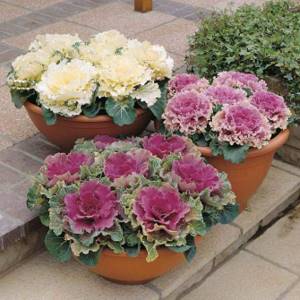
Prince
This hybrid variety is considered one of the most beautiful varieties of ornamental cabbage. It has a strong trunk with serrated leaves located on it. The socket does not deteriorate due to this feature, because no water gets into it. The ornamental cabbage bush is quite frost-resistant, and the hybrid is also resistant to rot. In autumn, when it’s cold, the leaves of the rosette turn from green to red.
Popular: Characteristics of growing tomato love f1
Bright autumn
This variety is similar to the “Princess” variety, but has a more compact rosette. "Bright Autumn" easily adapts after transplantation. She is not afraid of several transplants in one season. It can be grown as a houseplant. Is it possible to eat ornamental cabbage of this variety? Yes, it is edible.
Tokyo
This cabbage variety has a small height (from 20 to 30 centimeters). Its leaves are colored as if with a gradient. On one leaf it can vary from burgundy to pink. The variety itself may have rosettes of different colors. On sale there are seeds with purple, yellow, red colors, etc. The leaves are cut and look like they are corrugated.

Autumn medley
Ornamental cabbage does not grow tall. Its usual height is about 20 centimeters. Its rosette looks like a fancy flower. It is quite loose, with a green tint around the edges. Closer to the center of the rosette, the leaves turn red and yellow.
Fringed-leaved
The rosette of this variety reaches 40 centimeters. The elongated leaves with sharp edges make the variety particularly decorative. There is a fringe along their edge. Closer to the center of the head of cabbage, the leaves become crimson, and the edges are green with red streaks.
Lace mosaic
This variety of ornamental cabbage is larger than the previous ones. Ornamental cabbage can stretch up to 60 centimeters in height. The lace mosaic has a monochromatic leaf color and corrugated edges. The outer leaves are green, and the central ones can be blue, red or yellow. Often they also have bright inclusions throughout the sheet. The shape of the lace mosaic resembles a peony.
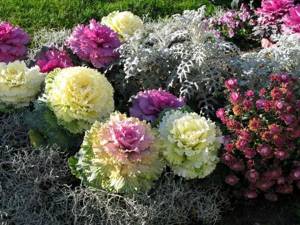
Kai and Gerda
This variety of cabbage is considered frost-resistant. It can survive frosts down to 10–15 degrees below zero. The biennial grows up to 70 centimeters in height. The leaves of the bush have a purple or green tint. They have excellent taste and are used for preparing first courses and salads.
Sunrise
This is a beautiful hybrid variety with several stems extending from the stalk. Each stem extends up to 45 centimeters. At the end there is a rosette, similar in shape to a rose. The decorative cabbage flower is unusual and looks impressive in a flower bed. Several shades are combined in one rosette. Combinations of pink, cream and green rosettes look most interesting in a flowerbed.
Russian circle
The perennial is quite compact. It reaches a height of no more than 30 centimeters. The head of cabbage is loose and shaped like a rose. The leaves have a rounded shape and bright veins.
